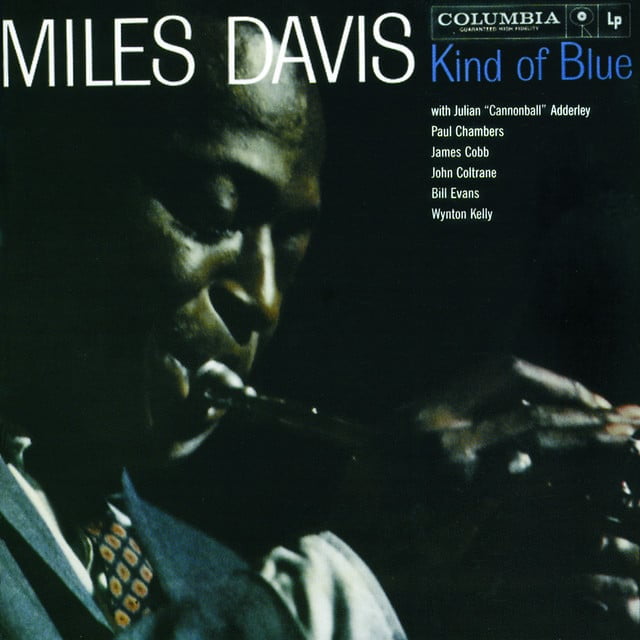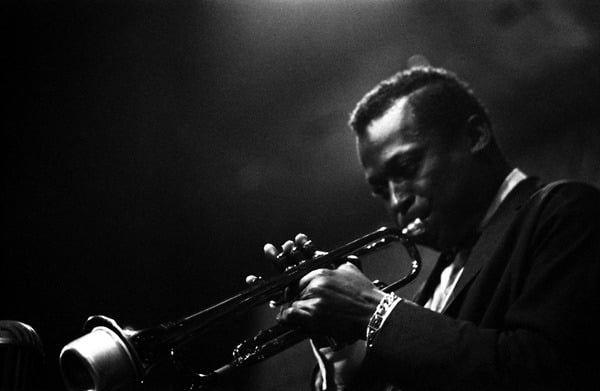"모든 곡이 테이크 원" 마일스 데이비스의 명반, 마티스와 닮았다
입력
수정
[arte]론 브랜튼의 Jazz it UP역사상 가장 위대한 재즈 음반 중 하나는 의심할 여지 없이 마일스 데이비스의 'Kind of Blue(Columbia Records)'입니다. 이 앨범은 음악뿐만 아니라 스타일과 미학적으로도 그 이후에 나온 앨범에 많은 영향을 준, 그야말로 마일스 데이비스의 걸작으로 꼽힙니다.
Kind of Blue, Kind of Evans, Kind of Simple

"데이비스는 비밥과 점점 더 복잡해지는 코드 변화와 멜로디 라인이 창의성을 저해한다고 불만을 품은 많은 재즈 뮤지션 중 한 명이었다."
데이비스는 조지 러셀이 쓴 유명한 재즈 이론서 < The Lydian Chromatic Concept of Tonal Organization for Improvisation >를 접한 적이 있었습니다. 에반스는 러셀과 함께 재즈 워크숍 녹음 작업을 하면서 엄격한 음조에서 벗어나자는 러셀의 아이디어를 받아들였습니다.
https://ko.wikipedia.org/wiki/%EB%AA%A8%EB%93%A4_%EC%9E%AC%EC%A6%88
재즈에 형식적 접근을 사용하는 이런 개방성은 뮤지션들이 주어진 키 안에서 작업하는 데만 신경쓰지 않고, 보다 다양하고 색다른 연주를 시도할 수 있게 했습니다. 음조의 화성에 국한하지 않고, 다양한 음계와 색채를 자유롭게 사용할 수 있다는 사실을 알게 된 것이죠.
화가 앙리 마티스가 노년에 완성한 '컷 아웃'을 그의 경력 초기의 그림과 비교하는 것이 적절한 비유가 될 수 있겠습니다. 1940년대 후반, 앙리 마티스는 거의 전적으로 단순하게 오려낸 종이를 주요 매체로 사용하고 가위를 주요 도구로 사용하면서 '컷 아웃'이라고 불리는, 근본적으로 새로운 작업을 도입했습니다.
마티스는 식물에서 추상까지 다양한 형태와 크기의 종이를 오려내 생동감 있는 구성으로 배열했습니다. 색과 대비의 유희가 뛰어난 것은 물론 물론 장식적 전략의 활용, 수단의 경제성 등이 돋보이는 작품을 선보인 것이죠. 마일스가 소리로 빚어낸 컷 아웃 작품이 바로 'Kind of Blue'입니다. 마티스의 오려낸 종이처럼 마일스가 사용한 재료는 단순했지만, 거장 뮤지션의 손에서 모든 위대한 예술처럼 시간과 장소를 초월하는 훨씬 더 위대한 것이 되었습니다.

이 녹음 프로젝트의 흥미로운 점은 '단순한 디자인'이지만 음악을 연주하는 아티스트의 역량으로 잠재력이 풍부한 결과물을 만드는 것이었습니다. 에반스는 인터뷰에서 이렇게 말합니다.
"... 모든 것(음악)은 뮤지션들 스스로가 어느 정도 만들어낸 것이고, 추가된 모든 것들은, (제가 ‘올 블루스’의 첫 소절에서 새가 날개를 퍼덕이듯이 연주한 멜로디 라인은) 재즈 연주자라면 누구나 추가할 수 있는, 그냥 던져 넣은 것입니다. 마일스는 소 왓이나 올 블루스에서처럼 '간단한 음악적 아이디어'를 만들어 낼 수 있는 능력이 있었기 때문에 이를 바탕으로 연주하면서도 여전히 독특하고 긍정적인 매력이 될 수 있는 무언가를 만들 수 있었죠, 아시겠죠? 따라서 올 블루스는 블루스이긴 하지만 특별한 종류의 블루스이고, 특별한 종류의 구조를 가지고 있으며, 차트에 모든 것이 담겨 있습니다."
마일스의 이 프로젝트에서 정말 좋았던 점은 마일스가 포착하고자 했던, 그야말로 생생한 에너지가 담긴 첫 테이크를 얻을 수 있었다는 것입니다.
에반스는 “이 앨범이 진짜 신선한 것은 아마 그런 식으로 작업되어졌기 때문일 겁니다. 왜냐하면 일반적으로 첫번째 테이크 때의 느낌이, 만약 그게 크게 틀리지만 않는다면, 보통은 최상의 테이크가 되거든요. 그래서 만약 첫번째 테이크가 채택되지 않을 경우, 일반적으로 그 이후 테이크에서는 뮤지션들의 감정적인 강렬함이 떨어지게 됩니다. 뮤지션들의 음악적인 강렬함이 떨어지고 나면, 다시 끌어올리는 작업을 해야겠죠. 그걸 다시 끌어올리는 것은 정말로 전문적이고, 또 많은 시간과 노력을 요하는 힘든 작업입니다. 그런 식으로 종종 빼어난 녹음물을 얻을 수도 있지만 이는 엄청난 작업을 요한다는 말이죠. 하지만 만약 첫번째 테이크가 충분히 좋으면 일반적으로 정말 좋은 테이크가 되죠.
에반스는 이런 종류의 음악에서 찰나의 순간에 대해 "재즈의 학문"이라고 말합니다.
"..재즈라는 분야는 돌아갈 수 없기 때문에 그런 종류의 음악에 집중합니다. 그리고 그것은 놀라운 분야입니다. 사회에서 가장 불안정하고 규율이 없는 사람들로 여겨지는 사람들이 실제로는 타의 추종을 불허하는 일종의 규율을 자신의 업무에 적용한다는 사실입니다. 작곡을 할 때는 오늘 기분이 안 좋으면 앉아서 내일 다시 시작하고, 6개월이 지나면 10분짜리 곡이 나올 수도 있죠. 하지만 재즈에서는 ‘딱이야!(bing)’가 있어야 하고, 그게 다죠. 빙은 “바로 그것!”하고 손가락으로 딱 소리를 내는 것이니.
그래서 저는 그 아이디어가 마음에 들어요. 재즈를 오래 할수록, 그리고 그 예술을 더 많이 발전시킬수록 거의 무의식적인 과정에 빠져들기 때문에 재즈를 하는 사람조차도 인식하지 못하는, 일종의 창조적 정신이 담겨있다고 봅니다.
자신도 의식하지 못하는 내면의 어떤 수준에서 말을 건네는 것이죠. 누가 알겠습니까? 우리는 우리가 무슨 말을 하고 있는 지조차 모릅니다. 재즈 전통의 일원으로서 우리는 어쩌면 예술적, 사회적 목표의 일부일지도 모르지만 그것이 무엇인지도 모른다고 생각해요. 하지만 한 가지 확실한 것은 우리가 직관적으로 재즈에 헌신했기 때문에 좋은 일이라고 생각합니다."
감상자로서의 우리에게도 시사하는 바가 크다. 우리가 Kind of Blue를 들을 때 모든 것을 새롭고 신선한 방식으로 조합하여 들을 수 있다는 것이다. 청취자이자 뮤지션으로서 예술의 과정에 대해 생각하는 방식-즉, 스타일에 대한 강조가 단지 얕은 차원의 것이 아니라-때때로 창의적으로 모든 것을 포괄할 수 있는 하나의 방식이라는 것 말이다.
<칼럼 원문> Kind of Blue, Kind of Evans, Kind of Simple
One of the greatest Jazz recordings ever done is, without a doubt, Kind of Blue by Miles Davis (Columbia Records). This album is considered by many as being Miles Davis' masterpiece, which has influenced so much which has come after it, not just in music but in style and esthetics.
Ashley Kahn noted in his work, The Making of Kind of Blue: Miles Davis and His Masterpiece bebop, that Davis was one of many jazz musicians growing dissatisfied with bebop and its increasingly complex chord changes and melodic lines as hindering creativity. Davis had been exposed to the ideas formulated by George Russell in his The Lydian Chromatic Concept of Tonal Organization for Improvisation. Evans had been working with Russell on his Jazz Workshop recording and had absorbed Russell's idea of getting away from strict tonality.
https://ko.wikipedia.org/wiki/%EB%AA%A8%EB%93%A4_%EC%9E%AC%EC%A6%88
The openness of using a modal approach to Jazz becomes apparent when we realize that, for this project, the musicians were not concerned with working within a key but were allowed to try various and different approaches to playing which gave them the freedom to use different scales and colors that were not confined to a tonal harmonic progression.
An appropriate analogy might be to compare the cut outs of Henri Matisse, done in his old age, to his paintings from earlier in his career. Appropriately enough, in the late 1940s, Henri Matisse turned almost exclusively to simple cut paper as his primary medium, and scissors as his chief implement, introducing a radically new operation that came to be called a cut-out. Matisse would cut painted sheets into forms of varying shapes and sizes — from the vegetal to the abstract — which he then arranged into lively compositions, striking for their play with color and contrast, their exploitation of decorative strategies, and their economy of means. Kind of Blue is Miles' sonic cut outs. The materials Miles used, like Matisse's cut paper, were simple, yet, in the hands of master musicians, became something far greater that transcends time and place, like all great art.
Together with Davis, Evans worked out musical ideas for the Kind of Blue project but, instead of creating finished pieces, Miles only gave the musicians melodies and scales. Pieces such as Freddie the Freeloader, All Blues, and So What where not written out in a score but were given in bits and pieces, verbally, to the musicians, who then created the music. This spontaneity is what Miles was after in his music.
Evans’ knowledge of harmony enabled him to thrive in this setting and when Miles asked him what he might do with such and such a chord progression, Evans went home and worked out a melody and wrote out charts for what became Blue and Green, which though listed as written by Miles Davis, is actually by Bill Evans.
The interesting main point of this recording project was to create something that though simple in design was rich in potential due to the maturity of the artists performing the music. As Evans elaborated in an interview: " . . . all of it (music) was more or less created out of the musicians themselves, and all the things that were added, now, like on All Blues you know the little fluttering figure I played at the beginning is just something I throw in, just like, anybody will add as jazz players to it, to a thing, but Miles had that ability to create a kind of simple figure, like on So What or All Blues, that still generates a complete and positive reference off of which you can play and still relate to something which is unique, see? And so even though All Blues is a blues, it’s a particular kind of blues, it has a particular kind of structure, and it’s all contained in the chart, really."
The really strong thing about working the way Miles did on this project is that it results in absolutely vivid first takes, which is the sort of energy that Miles was looking to capture. Evans observed that "I think maybe that accounts for some of the real freshness. ‘Cause, first take feelings are generally, if they’re anywhere near right, they’re generally the best, and if you don’t take that one, generally you take a dip emotionally. You go down, and then you have to start working your way up. It’s really a professional, laborious process of bringing yourself back up, and you can often get to a superior take that way, but it becomes a lot of work, but if you can get that first fresh take and it’s good enough, generally that’s a real good one. And that may account for some of the success of this album, that all of those takes are the first takes."
Evans further talks about the fleeting moments in this sort of music which is a "Jazz discipline": ". . . the jazz discipline, to that kind of thing because you can’t go back. And it’s a remarkable discipline. For people that are considered to be the most unstable, undisciplined members of society, the fact is that they bring to bear a kind of a discipline on their work that is practically unparalleled. And you can’t, like if you compose, you could sit down, if you don’t feel like it today, come back tomorrow, and after six months you might have ten minutes of music. But in jazz, it’s gotta be “bing” and that’s it.
So, I love the idea of it. I think it locks into a kind of a creative mental process that has implications far beyond the people that even are doing it are aware, because the longer you do it, and the more you develop that art, the more you’re locking into an almost subconscious process.
It’s speaking from some levels of yourself that you’re not even aware of. Who knows? We don’t have any idea what we’re even saying. I think we’re part of a even perhaps an artistic and social goal as members of a jazz tradition that we have no idea what it might be either. But I think one thing we do know is it’s a good thing because we intuitively committed to ourselves to it for that reason."
When we listen to Kind of Blue, we are hearing all of this, put together in a fresh, new way that has influenced how we, as listeners and musicians think about process in the arts and how that emphasis upon style is not a shallow thing but is sometimes all encompassing in its creative embrace.